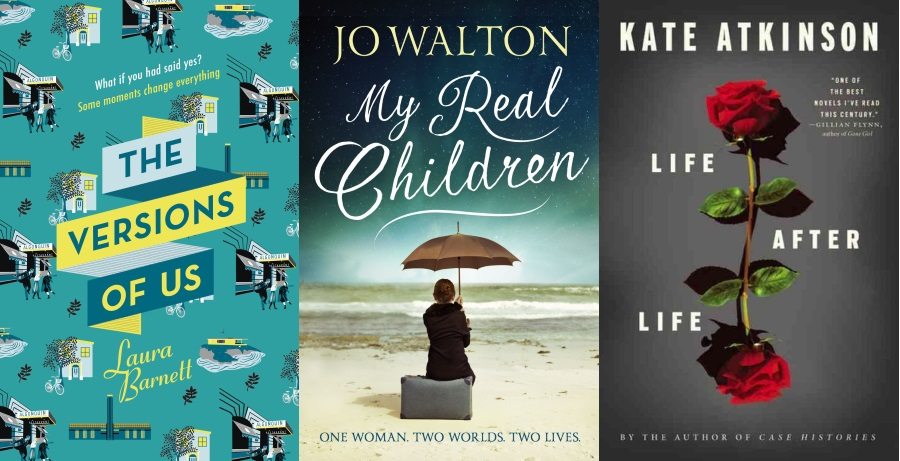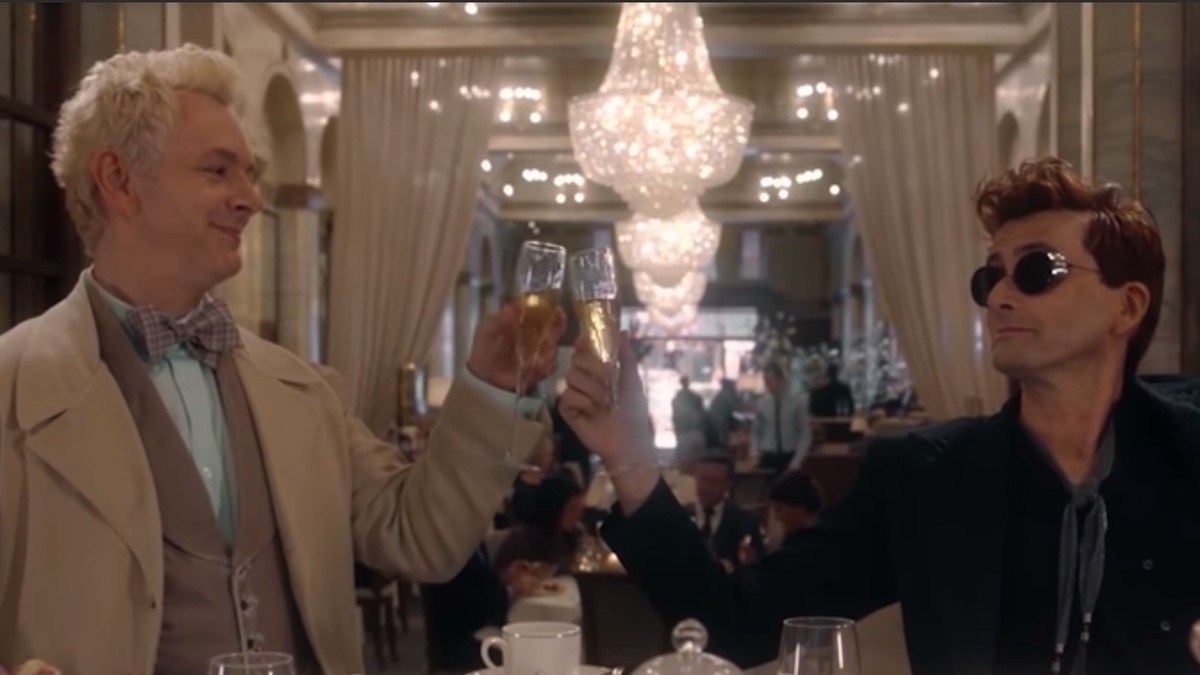 Parallel universes have long been a mainstay of science fiction. They are an attractive proposition, allowing the exploration of themes and ideas in familiar surroundings, whilst breaking free from the rigidity of the story being set at home. Throw in some time-travel and a bit of alternate history and you have pretty much covered two-thirds of works in the SF genre. (I pluck that figure out of the air; in your universe it may be different).
Parallel universes have long been a mainstay of science fiction. They are an attractive proposition, allowing the exploration of themes and ideas in familiar surroundings, whilst breaking free from the rigidity of the story being set at home. Throw in some time-travel and a bit of alternate history and you have pretty much covered two-thirds of works in the SF genre. (I pluck that figure out of the air; in your universe it may be different).
Worlds with wormholes, where Hitler won, and quantum leaps are abundant across the genre, but recently I’ve noticed the parallel universe has started to make an appearance in more mainstream, literary forms. ‘Sliding Doors’ novels have started to turn up in the front windows of bookshops and on broadsheet bestseller lists. It seems that more traditional authors have suddenly caught up with the storytelling potential of the parallel universe.
I’ve read six sliding doors novels recently, all appearing in differing places along the speculative spectrum.
The least science fictional of the my choices is The Versions of Us by Laura Barnett. The story here forks from a chance meeting between two Oxford students on a dark night in 1938. The narrative splits into three prongs. One where the couple date and get married, one where they split up and another where the initial meeting never happens.
After the initial split, the three narratives don’t really interact with one another. There’s no crossing of the time-streams. What Barnett does though is show how life can take many paths and how all be filled with difficult trials and moments of joy. She cleverly shows how contentment in one aspect in your life can cause you to drop the ball in another and how adversity can spur on endeavor. The novel’s cleverest trick is to build up a three-dimensional picture of its characters. In a conventional narrative we only see characters from one perspective. Here Barnett uses each story like a camera lens aimed at different angles. We get to see how characters might respond to the same situation under different pressures, giving us a more rounded view. The Versions of Us is a story about life, how to live it and how not to regret the bits that you didn’t.
Similar, and my favorite of the novels mentioned here is Jo Walton’s My Real Children. Walton gives us two narratives that alternate with each chapter of the book, starting from a marriage proposal and the question, “Now or never?” My Real Children is more overtly science fiction than The Versions of Us, with two parallel universes that differ subtly from our own. I particularly enjoyed the way Walton handled her alternate histories. They are subtle enough to make you almost miss them, then have to back up a sentence or two to fully take in what just happened. Much like The Versions of Us, this novel shows there is more than one path to happiness. It’s a beautiful meditation on the wonders of family life and a gentle reminder that now matter how progressive each generation thinks it is, their children will always be able to chuck them the occasional curve ball.
Kate Atkinson’s Life After Life is a sprawling novel, that is not so much about parallel universes but stacking ones. Ursula’s life keeps repeating. After she dies, on the next repeat, she is able to avoid it, and continue on, having had a narrow escape. Her lives branch out from dying immediately after being born, into numerous different stories; some happy, some sad, some mundane, and some momentous.
Much of the story occurs during World War II, both in England and Germany. Atkinson paints a vivid portrait of wartime on both sides of the divide. There is a clever feathering of Ursula’s lives throughout, with central characters in some strands turning up as passers-by in others. Atkinson is one of my favorite writers. Her writing style is second to none and her powers of observation are acute and accurate. Life After Life is a novel about potential. If it has a message, it’s that we only have one life and we should try to make the most of it.
 The science fiction elements of Life after Life are small, but Claire North’s, The First Fifteen Lives of Harry August is out and out SF. It’s the first of these books mentioned to have been published by an SFF imprint (Orbit). After death, Harry August returns to the point of his birth still able to remember everything that has gone before. For each of his incarnations, he returns to the start with the sum total of the knowledge he’s acquired. He is living a Groundhog Life.
The science fiction elements of Life after Life are small, but Claire North’s, The First Fifteen Lives of Harry August is out and out SF. It’s the first of these books mentioned to have been published by an SFF imprint (Orbit). After death, Harry August returns to the point of his birth still able to remember everything that has gone before. For each of his incarnations, he returns to the start with the sum total of the knowledge he’s acquired. He is living a Groundhog Life.
It turns out there are a number of these so-called “kalachakrans,” each looking out for one another as part of a parallel universe-spanning secret society. When Harry receives a message handed down from the future that the world is soon to end, he endeavors to find out what’s going on and save not just his current universe, but countless others. Featuring the Cold War, time travel, and quantum physics, The First Fifteen Lives of Harry August is an intricate construction and makes for an invigorating read.
If North’s novel is more overtly SF than my other choices, David Wingrove’s Empire of Time by comparison is a DeLorean on top of a police box, bolted onto a Star Destroyer. This book is as SF as they come. Time travel has been made possible but has led to an eternal conflict between Germany and Russia. Set (mostly) in medieval Europe, World War Two, and the far future, Empire of Time is a bamboozling tale of time-altering plots and counter-plots, with people popping up to mess things up when you least expect them. It’s an absolute riot. If its SF credentials were in any doubt, Empire of Time is the first book of a trilogy.
My final pick for parallel universes is a wonderful multi-threaded novel about science fiction writing and the creation of fictional parallel universes. The central conceit of Jake Arnott’s The House of Rumour is that science fiction writers of the 1940s were tasked with helping out intelligence agencies during World War II. They were asked to propagate rumours in their stories of technological innovations that may or may not have been true.
The House of Rumour flits about time periods like an attention-deficient butterfly, rarely settling anywhere for long. Arnott blends fact, fiction, and facts about fiction in wonderfully inventive manner. His meandering plot and peculiar structure (around a tarot deck) won’t suit all tastes, but the book was unlike anything I’d read before. Arnott is perhaps more famous for writing sparse 1960s gangster novels, and House of Rumour marked a massive departure for him. It is definitely his finest moment. A brilliantly constructed, fiercely intelligent novel, soaked in the golden age of science fiction, with nested parallel universes. What’s not to like?
I enjoyed all these parallel universe novels immensely. “What if?” is an idea that continues to inspire a wide variety of writers into producing some wonderful fiction. I’m sure there are many more universes to be explored. Has anybody else read any great parallel universe stories recently? What are the classics of the genre that should not be missed? Please add your suggestions in the comments.
I received a copies of The Version of Us, Life After Life, My Real Children, and The Empire of Time for review.




